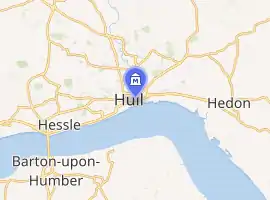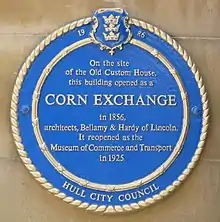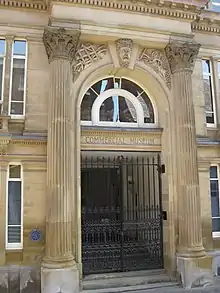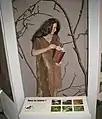Hull and East Riding Museum
The Hull and East Riding Museum is located in the Museums Quarter of the Old Town in Kingston upon Hull, England. It dates back to 1925 as the Museum of Commerce and Industry in a former Customs House but acquired its present name in 1989 with a major refurbishment and new entrance, with the transport section moving to a separate museum. It displays items from prehistoric to medieval in the area, many of them in life-size tableaux or reconstructions of rooms and buildings.
 | |

| |
| Established | 1989 |
|---|---|
| Location | Kingston upon Hull, England |
| Coordinates | 53.7434°N 0.3303°W |
| Visitors | 76,792 (2014) |
| Curator | Caroline Rhodes |
| Public transit access | Hull Paragon Interchange (10 minute walk) |
| Website | www |
History


Building number 36 on the High Street was a customs house. It was replaced by a new building, Hull Corn Exchange, in 1856, but later fell into disuse and disrepair. The structure was refurbished and opened as a museum in 1925, being the Museum of Commerce and Industry. It was damaged by bombs during the Second World War but renovated and reopened as the Archaeology and Transport Museum in 1957.[1]
In 1989 the museum was given its present name, and was refurbished as the transport collection moved to a new adjacent museum called Streetlife Museum of Transport.[2] The museum underwent a further major makeover between 1998 and 2003 as part of the creation of the Museums Quarter, with the main entrance transferred from the High Street to the central courtyard.[3][4]
Galleries
A major feature is several galleries where actual artifacts (found in the region) are displayed in tableaux showing life in a particular time, and includes up to full size rooms or buildings.[5][6]
Fossils and Early Animals
Visitors enter to see a giant woolly mammoth with other extinct animals from the region and some interactive displays including fossils which can be touched.[5][7][8]
Prehistoric Man
This includes a tableau of a woman as a gatherer and explanations of the diet and technology of early humans. There are stone tools and Bronze Age pottery, metal goods and wooden carvings. Many of these were collected by notable archaeologist John Robert Mortimer (1825–1911).[8]
Celtic Worlds
This includes a reconstruction of substantial parts of an Iron Age village and its people talking in ancient Welsh.[5][8] A translation is available at reception.[9]
Boat Lab
This shows the Hasholme Logboat, some 41.9-foot-long (12.78 m) and 4.6-foot-wide (1.4 m) carved from a single oak tree, dating back to about 300 BC.[8][10] There is also part of one of three Ferriby Boats from about 2000 BC, the oldest known sewn plank boats in Europe.[5][11][12]
Roman World (AD 43–410)
This includes a reconstruction of part of the Roman settlement of Petuaria (modern day Brough, East Riding of Yorkshire).[4][8] Large (actual) mosaics are displayed as they would have been within houses.[5] A Roman bath house contains not only an original mosaic, but also a life-sized bather.[6] There are also a workshop, office and shop, in which artifacts from the time are displayed as if for sale. A humorous feature is the Latin graffiti Romani ite domum ("Romans go home") on the wall of a building.
The museum displays a number of mosaics which were found at the sites of Roman villas at Rudston, Brantingham and Harpham in the East Riding, and at Horkstow in north Lincolnshire. They are considered to be the best collection of late Roman mosaics to be seen in Britain.[13]
Upper galleries
These depict life in East Yorkshire from the end of Roman occupation (AD 410) to the outbreak of the English Civil War including the Saxons, the Vikings and Mediaeval Hull. This includes coins, weapons, stone carvings and everyday objects.[8]
 Woolly mammoth
Woolly mammoth Woman the Gatherer?
Woman the Gatherer?.JPG.webp) Stone age items
Stone age items.JPG.webp) Bronze Age wood carvings
Bronze Age wood carvings Bronze Age swords
Bronze Age swords Iron Age village
Iron Age village Hasholme log boat
Hasholme log boat Part of Petuaria "Romans go home"
Part of Petuaria "Romans go home" Roman bath house
Roman bath house Roman room
Roman room Pottery from Mediaeval Hull
Pottery from Mediaeval Hull.JPG.webp) Mediaeval Hull stone carvings
Mediaeval Hull stone carvings
References
- "Looking beyond the displays: A history of The Hull and East Riding Museum". www.kcomhome.com. 1 March 2017. Retrieved 10 July 2018.
- Tait, Simon (25 March 1989). "On the road again; Museums". The Times.
- Young, Angus (21 May 1998). "GBP 100,000 closes cash gap Final funding for museum revamp". Hull Daily Mail.
- "Visitors Swarm To Museums Spectacular". Hull Daily Mail. 14 June 2003.
- Simon, Jos (2015). The Rough Guide to Yorkshire. Rough Guides UK. p. 277. ISBN 9780241216323.
- Chrystal, Paul (2017). Hull in 50 Buildings. Amberley Publishing. p. 56. ISBN 978-1445664804.
- "Another mammoth attraction". Yorkshire Post. 8 April 2003.
- "Hull and East Riding Museum Galleries". www.hcandl.co.uk. Hull City Council. Retrieved 10 July 2018.
- "The Iron Age in East Yorkshire: a guide to the audio heard in the gallery" undated, Hull City Council, obtained July 2018
- Lillie, Malcolm (2005). "Deconstructing Reconstruction: The Bronze Age Sewn Plank Boats from North Ferriby, River Humber, England, UK and their Context". Journal of Wetland Archaeology. 5 (1): 97–109. doi:10.1179/jwa.2005.5.1.97.
- Wright, Edward; et al. (2001). "New AMS radiocarbon dates for the North Ferriby boats--a contribution to dating prehistoric seafaring in northwestern Europe". Antiquity. 75 (290): 726–734. doi:10.1017/s0003598x00089237.
- "Ferriby Boat model". www.bbc.co.uk. BBC. Retrieved 10 July 2018.
- Smith, David (2005). Roman Mosaics at Hull. ISBN 0904490 34 3.
| Wikimedia Commons has media related to Hull and East Riding Museum. |